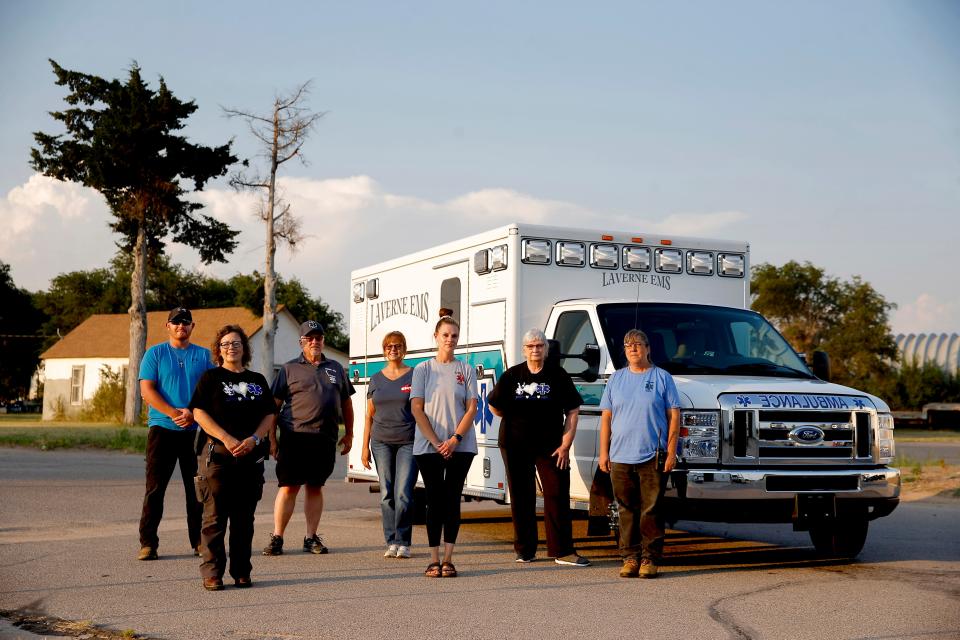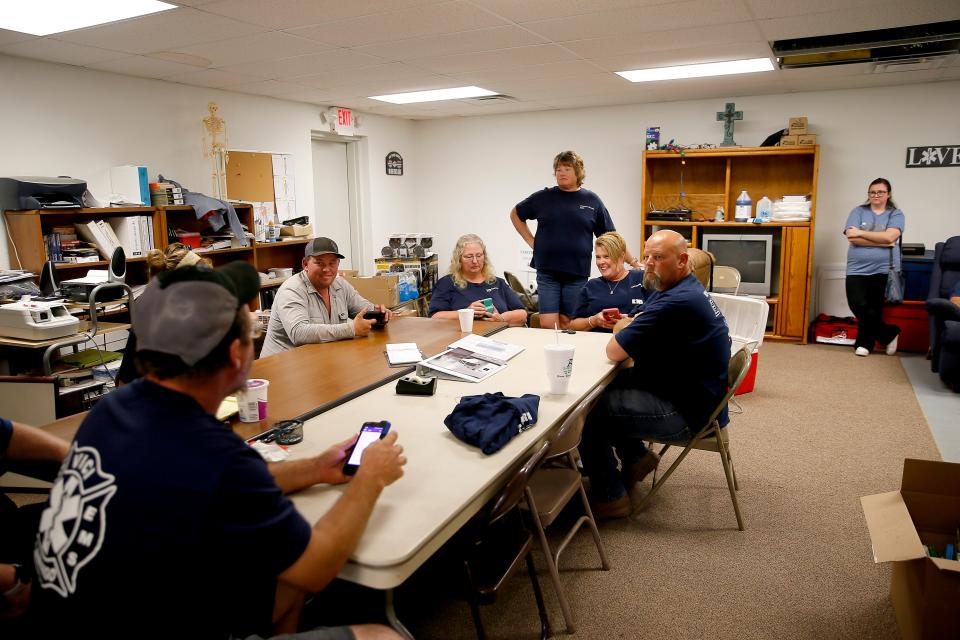'Rural EMS is in trouble': Volunteer ambulance services face staffing shortages
LAVERNE — A retired nurse who farms. A beauty salon owner with four children. A minister who is going back to school.
These are among the nine people who make up the volunteer ambulance service in Laverne, tasked with covering more than 800 square miles in Harper County.
It’s not enough. Like many rural ambulance services in Oklahoma and across the country, Laverne is struggling to find volunteers to keep up with the demands of medical emergencies in this rural area 180 miles northeast of Oklahoma City. The difficulty has become even more acute during the pandemic as businesses across every segment — rural and urban — are having difficulty filling jobs.
“That’s the scary part about a rural volunteer service. Right now, I’m scraping by on staffing,” Laverne EMS director Bobbie Mitchell said. “If one major event happens to myself or my assistant, we’re not covered.
“Rural EMS is in trouble, and that’s not just my service.”
Nearly 1.3 million Oklahomans live in rural areas such as Laverne, according to data from the United States Department of Agriculture, and many rely on volunteer ambulance services.
With shrinking and aging populations, rural communities such as Laverne don’t have many prospective volunteers. And even though some community members say they’re willing to help, few say they have the time to do so.
The problem, ambulance service officials say, is this: If people aren’t volunteering to respond to emergencies, who will answer calls for help?
“It’s absolutely taken for granted: You call 911 and you need an ambulance, and the ambulance comes,” Mitchell said. “Just like air and water, we take it for granted.”
More: EMSA response times below standards due to staffing shortages

Rural ambulances fill critical need despite low volunteer numbers
In some rural communities, volunteer ambulance services are the only ones nearby when people call 9-1-1, and without them, patients could suffer.
Scientific studies show that longer ambulance response times can increase a patient’s risk of death. A 2020 study published in the Journal of the American Heart Association found that shortened ambulance response times improve a patient’s chance of surviving a heart attack.
Another 2020 study, published by the National Library of Medicine, found patients’ risk of dying from an out-of-hospital cardiac arrest doubled if an ambulance’s response time is more than eight minutes.
Some rural Oklahomans could be — and have been — forced to wait even longer. For about a year in 2007, the Vici-Camargo volunteer ambulance service in rural Dewey County closed because of a volunteer shortage. Residents in its coverage area had to wait for ambulances to arrive from Woodward, Leedey, Seiling and Arnett. All are at least 20 miles away from Vici.
“If we lose our ambulance, the next closest ambulance is like 30 minutes away,” said Eric Peoples, an EMT with the Vici-Camargo service. “I can almost promise you, in the year or so we were out of service, that there were probably some patients that suffered some detrimental effects from extended response time.”
Pandemic recovery: Oklahoma health experts call for emergency declaration as COVID surges again
Low pay, other obligations make staffing difficult
Volunteer ambulance services rely on the donated labor of community members to survive. Some volunteers work for no pay, some receive small stipends per call they respond to, and others collect small hourly pay (often below minimum wage). They are considered volunteers because in each case the pay is too minimal to earn a living, and thus the work is volunteered in spare time away from other jobs.
These volunteers often give up nights and weekends to stay on-call for the ambulance service. Some take off only one weekend each month.
“It’s just hard,” Mitchell said. “People know they can’t make any money at it. People have kids, and those kids have activities, and it’s hard to juggle your life with all the activities that kids bring along with it."
For those willing and able to volunteer, training often takes months’ worth of work before they can even set foot in an ambulance.
Some agencies, such as Laverne, offer training in-house. Others send volunteers to community colleges and trade schools to complete coursework.
The amount training has increased over the past 30 years, said Greg Reid, president of the Oklahoma Ambulance Association. But it is necessary to provide the kind of care expected by an ambulance service.
“A good percentage of my patients, I know them personally,” Peoples said. “Metropolitan agencies don’t have that. They’re working on strangers. I’m working on friends, neighbors and family. That’s a large part of my inspiration. They’re depending on you, perhaps, to perform lifesaving measures.”
Population declines decrease volunteer pool

The pandemic has made hiring difficult for businesses across the nation. And for rural ambulance services, it’s compounding an existing problem: population decline.
“There is a population drain that is occurring in rural Oklahoma,” said Dale Adkerson, who oversees the state health department's EMS division. “This is not new. But, when you start talking about workforce, as you have fewer people to draw from inside of small communities, you either have to import your staff — which means you’re going to have to pay them — or you’re going to have to grow your own."
Laverne needs about 14 volunteers to help cover shifts, Mitchell said.
Vici-Camargo only has eight volunteers who regularly fill shifts, Peoples said, not far from the two it had in 2007, when it was forced to close.
“The concept of volunteerism isn’t as strong as it used to be, not only in EMS,” Reid said. “There just are not as many people volunteering and doing the service, even if they get a small stipend to help cover their expense or whatever else.”
COVID-19 vaccinations: Oklahoma health systems face backlash over vaccine requirements for workers
Opinions differ on solutions

Ambulance service leaders say they’re not sure how to get new volunteers on staff. And some in the industry say another form of EMS may be the most viable option.
In places where a volunteer ambulance service may not be sustainable, Reid proposes creating emergency medical response agencies. This is the idea: Have a single, full-time EMR or paramedic in a given area who can respond and initiate treatment on a patient while waiting for an ambulance from another community.
“If it’s a life-threatening emergency, it’s exactly the same thing the ambulance personnel would do," Reid said. "Yet [the patients] are getting taken care of sooner, even if the ambulance is farther away.”
Reid helped develop such a system in Pottawatomie County about five years ago, he said. So far, the program has been successful.
“The only resource that we could come up with easily was one that costs more than a volunteer service,” Reid said. “You could do that in several of the small towns. … You could do it on a volunteer basis with people.”
Reid said he believes an existing grant program from the state health department — the Oklahoma Emergency Response Systems Stabilization and Improvement Revolving Fund — could help start a few such agencies each year if state legislators increase funding for it.
Starting such an agency could cost between $150,000 and $200,000, Reid said.
“I think that if you could start two or three of those a year, and then start two or three the next year, you would realize over a short period of time, other places might come up with a way to get their money without a grant."
That idea isn’t popular with some ambulance providers, however. Peoples said he believes such a program would ultimately decrease the quality of care patients receive, and it doesn't do anything to shorten response times with an actual ambulance.
“The people that promote that type of a setup really don’t understand the geography out here in rural Oklahoma,” Peoples said. “Maybe in a more populated area, but out in this country, the response times are too long. I don’t think that’s a viable option.”
Both Peoples and Mitchell say rural ambulance services provide essential services in their communities. Mitchell said her goal is to show people how important ambulance services are to their communities by advertising training sessions and reaching out to community members via social media.
She's not sure if her plan will work.
“I don’t know what that solution is," she said. "If you find one, I’d sure like to know.”
This article originally appeared on Oklahoman: Why Oklahoma's rural EMS agencies are facing staffing shortages

